Optimizing Cross-Regional Mobility Contributes to the Metacoupling Between Urbanization and the Environment for Regional Sustainability
Abstract
1. Introduction
2. Materials and Methods
2.1. Study Area
2.2. Data Sources and Processing
2.3. Methods
2.3.1. Research Framework
2.3.2. Construction of Index System
2.3.3. Calculation of Cross-Regional Flow of Multi-Factors
- (1)
- Population flow
- (2)
- Economic flow
- (3)
- Information flow
2.3.4. Calculation of Cross-Regional Flow of ESs
2.3.5. Evaluation of Coupling Coordination Degree
2.3.6. Geodetector Model
3. Results
3.1. Spatial Pattern of Urbanization Level
3.2. Spatial Pattern of Environment Level
3.3. Analysis of the Metacoupling Between Urbanization and the Environment
3.3.1. Intracoupling
3.3.2. Pericoupling
3.3.3. Telecoupling
3.4. Factors Affecting the Intracoupling, Pericoupling, and Telecoupling
3.4.1. Main Factors
3.4.2. Interactions Between Cross-Regional Flow of Multi-Factors
4. Discussion
4.1. Exploring the Relationship Between Production Factor Flows and Urbanization Level
4.2. Exploring the Relationship Between ES Flow and Environment Level
4.3. Main Factors Influencing the CCD from Local to Distant Levels
4.4. Limitations and Future Erspectives
5. Conclusions
- 1.
- During the study period, the UL of the CCUA was highly polarized when local flows of production factors were not taken into account. However, the southwestern region showed urban improvement, when cross-regional flows of production factors were considered.
- 2.
- The overall EL of the CCUA was good when local flows of ESs were not taken into account, whereas the surrounding areas experienced ecological degradation when cross-regional flows of ESs were considered.
- 3.
- The overall coupling degree between urbanization and the environment in the CCUA was low. However, the cross-regional flow of production and ES factors may enhance the coupling from local to distant scales. In the CCUA, production factor flows and ES flows were found to be the common factors that affected the metacoupling between urbanization and the environment.
- 4.
- Both production factor flows and ES flow played important roles in the metacoupling between urbanization and the environment of the CCUA, with varying explanatory power at different scales. Among them, population and economic flows have stronger explanatory power at local scales, ES flow and population flow have stronger explanatory power at adjacent scales, and economic flow and ES flow have stronger explanatory power at long-distance scales.
Author Contributions
Funding
Data Availability Statement
Conflicts of Interest
References
- Liu, L.; Guo, Y.; Li, Y.; Zhang, L. Examining the complex relationship between Urbanization and ecological environment in ecologically fragile areas: A case study in Southwest China. Front. Public Health 2024, 12, 1358051. [Google Scholar] [CrossRef]
- UN. 2018 Revision of World Urbanization Prospects: New York, USA: United Nations Department of Economic and Social Affairs (Population Division). 2018. Available online: https://www.un.org/zh/desa/2018-revision-world-urbanization-prospects (accessed on 16 May 2018).
- Northam, R.M. Urban Geography; John Wiley & Sons: New York, NY, USA, 1975. [Google Scholar]
- Zhang, M.; Tan, S.; Zhang, Y.; He, J.; Ni, Q. Does land transfer promote the development of new-type urbanization? New evidence from urban agglomerations in the middle reaches of the Yangtze River. Ecol. Indic. 2022, 136, 108705. [Google Scholar] [CrossRef]
- Ai, J.; Feng, L.; Dong, X.; Zhu, X.; Li, Y. Exploring coupling coordination between urbanization and ecosystem quality (1985–2010): A case study from Lianyungang City, China. Front. Earth Sci. 2016, 10, 527–545. [Google Scholar] [CrossRef]
- Wu, X.; Zhang, Y.; Li, X. Exploring the Relationship between Urbanization and Eco-Environment Using Dynamic Coupling Coordination Degree Model: Case Study of Beijing–Tianjin–Hebei Urban Agglomeration, China. Land 2024, 13, 850. [Google Scholar] [CrossRef]
- Zhao, Y.; Wang, S.; Zhou, C. Understanding the relation between urbanization and the eco-environment in China’s Yangtze River Delta using an improved EKC model and coupling analysis. Sci. Total Environ. 2016, 571, 862–875. [Google Scholar] [CrossRef] [PubMed]
- Wang, Y.; Song, M.; Han, Y.; Wang, Y. Multi-scale coupling measurement and driving factor analysis between carbon emission from energy consumption and ecological environment—The case study of Pearl River Delta urban agglomeration. Sustain. Cities Soc. 2025, 127, 106425. [Google Scholar] [CrossRef]
- Song, D.; Wang, S.; Shilong, M. Coupling Coordination of Multi-Dimensional Urbanization and Ecological Security in Karst Landscapes: A Case Study of the Yunnan–Guizhou Region, China. Sustainability 2024, 16, 6629. [Google Scholar] [CrossRef]
- Li, Y.; Wang, S. Exploration of Eco-Environment and Urbanization Changes Based on Multi-Source Remote Sensing Data—A Case Study of Yangtze River Delta Urban Agglomeration. Sustainability 2024, 16, 5903. [Google Scholar] [CrossRef]
- Steffen, W.; Broadgate, W.; Deutsch, L.; Gaffney, O.; Ludwig, C. The trajectory of the Anthropocene: The Great Acceleration. Anthr. Rev. 2015, 2, 81–98. [Google Scholar] [CrossRef]
- Fang, G.; Sun, X.; Zheng, H.; Zhu, P.; Wu, W.; Yang, P.; Tang, H. Optimizing the ecosystem service flow of grain provision across metacoupling systems will improve transmission efficiency. Appl. Geogr. 2024, 172, 103420. [Google Scholar] [CrossRef]
- Liu, R.; Dong, X.; Wang, X.; Zhang, P.; Liu, M.; Zhang, Y. Relationship and driving factors between urbanization and natural ecosystem health in China. Ecol. Indic. 2023, 147, 109972. [Google Scholar] [CrossRef]
- Lei, X.; Liu, H.; Li, S.; Luo, Q.; Cheng, S.; Hu, G.; Wang, X.; Bai, W. Coupling coordination analysis of urbanization and ecological environment in Chengdu-Chongqing urban agglomeration. Ecol. Indic. 2024, 161, 111969. [Google Scholar] [CrossRef]
- Xu, D.; Yang, F.; Yu, L.; Zhou, Y.; Li, H.; Ma, J.; Huang, J.; Wei, J.; Xu, Y.; Zhang, C.; et al. Quantization of the coupling mechanism between eco-environmental quality and urbanization from multisource remote sensing data. J. Clean. Prod. 2021, 321, 128948. [Google Scholar] [CrossRef]
- Cai, J.; Li, X.; Liu, L.; Chen, Y.; Wang, X.; Lu, S. Coupling and coordinated development of new urbanization and agro-ecological environment in China. Sci. Total Environ. 2021, 776, 145837. [Google Scholar] [CrossRef]
- Zhao, G.; Liang, R.; Li, K.; Wang, Y.; Pu, X. Study on the coupling model of urbanization and water environment with basin as a unit: A study on the Hanjiang Basin in China. Ecol. Indic. 2021, 131, 108130. [Google Scholar] [CrossRef]
- Ariken, M.; Zhang, F.; Chan Nw Kung, H.-T. Coupling coordination analysis and spatio-temporal heterogeneity between urbanization and eco-environment along the silk road economic belt in China. Ecol. Indic. 2021, 121, 107191. [Google Scholar] [CrossRef]
- An, H.; Xiao, W.; Huang, J. Relationship of construction land expansion and ecological environment changes in the Three Gorges reservoir area of China. Ecol. Indic. 2023, 157, 111209. [Google Scholar] [CrossRef]
- Song, Y.; Gao, Y.; Zhang, S.; Dong, H.; Liu, X. Research on the Coupling Coordination and Driving Mechanisms of New-Type Urbanization and the Ecological Environment in China’s Yangtze River Delta. Sustainability 2024, 16, 5308. [Google Scholar] [CrossRef]
- Liu, J. Integration across a metacoupled world. Ecol. Soc. 2017, 22, 29. [Google Scholar] [CrossRef]
- Liu, J. Leveraging the metacoupling framework for sustainability science and global sustainable development. Natl. Sci. Rev. 2023, 10, 90. [Google Scholar] [CrossRef]
- Li, Y.; Jia, N.; Yu, X.; Manning, N.; Lan, X.; Liu, J. Transboundary flows in the metacoupled Anthropocene: Typology, methods, and governance for global sustainability. Ecol. Soc. 2023, 28, 19. [Google Scholar] [CrossRef]
- Zhang, L.; Huang, Q.; Qiu, J.; Liao, C.; Liu, Z.; He, C.; Bai, Y.; Chen, P.; Zhou, Y.; Liu, Y.; et al. Measuring virtual flows of ecosystem services embedded in traded goods across an urban agglomeration in China. Ecosyst. Serv. 2024, 69, 101651. [Google Scholar] [CrossRef]
- Herzberger, A.; Chung, M.G.; Kapsar, K.; Frank, K.A.; Liu, J. Telecoupled Food Trade Affects Pericoupled Trade and Intracoupled Production. Sustainability 2019, 11, 2908. [Google Scholar] [CrossRef]
- Zhang, J.; He, C.; Huang, Q.; Li, L. Understanding ecosystem service flows through the metacoupling framework. Ecol. Indic. 2023, 151, 110303. [Google Scholar] [CrossRef]
- Li, P.; He, C.; Huang, Q.; Wang, Y.; Duan, X. Metacoupling flow of embodied carbon in resource-based cities: A case study of Hohhot-Baotou-Ordos-Yulin urban agglomeration in China. Energy 2024, 313, 134041. [Google Scholar] [CrossRef]
- Wu, W.; Huang, Y.; Zhang, Y.; Zhou, B. Research on the synergistic effects of urbanization and ecological environment in the Chengdu–Chongqing urban agglomeration based on the Haken model. Sci. Rep. 2024, 14, 117. [Google Scholar] [CrossRef]
- Yang, J.; Li, Z.; Zhang, D.; Zhong, J. An empirical analysis of the coupling and coordinated development of new urbanization and ecological welfare performance in China’s Chengdu–Chongqing economic circle. Sci. Rep. 2024, 14, 13197. [Google Scholar] [CrossRef]
- Lei, Y.; Xiao, Y.; Wang, F.; Wang, R.; Huang, H. Investigation on the complex relationship between urbanization and eco-efficiency in urban agglomeration of China: The case study of Chengdu-Chongqing urban agglomeration. Ecol. Indic. 2024, 159, 111704. [Google Scholar] [CrossRef]
- Wu, X.; Liu, J.; Fu, B.; Wang, S.; Wei, Y. Integrating multiple influencing factors in evaluating the socioeconomic effects of payments for ecosystem services. Ecosyst. Serv. 2021, 51, 101348. [Google Scholar] [CrossRef]
- Zhao, F.; Liu, X.; Zhao, X.; Wang, H. Effects of production–living–ecological space changes on the ecosystem service value of the Yangtze River Delta urban agglomeration in China. Environ. Monit. Assess. 2023, 195, 1133. [Google Scholar] [CrossRef]
- Li, W.; Wang, Y.; Xie, S.; Cheng, X. Coupling coordination analysis and spatiotemporal heterogeneity between urbanization and ecosystem health in Chongqing municipality, China. Sci. Total Environ. 2021, 791, 148311. [Google Scholar] [CrossRef] [PubMed]
- Zhang, Y.; Wang, X.; Ji, M.; Chen, Y.; Yan, F. Evaluating the barrier of typical production factor flow in the Chengdu-Chongqing Urban Agglomeration based on multi-source big data. Front. Environ. Sci. 2022, 10, 1048378. [Google Scholar] [CrossRef]
- Wang, X.; Ding, S.; Cao, W.; Fan, D.; Tang, B. Research on Network Patterns and Influencing Factors of Population Flow and Migration in the Yangtze River Delta Urban Agglomeration, China. Sustainability 2020, 12, 6803. [Google Scholar] [CrossRef]
- Yangtianzheng, Z.; Ying, G. Spatial patterns and trends of inter-city population mobility in China—Based on Baidu migration big data. Cities 2024, 151, 105124. [Google Scholar] [CrossRef]
- Taylor, P.J.; Walker, D.R.F.J.U.S. World Cities: A First Multivariate Analysis of their Service Complexes. Urban Stud. 2001, 38, 23–47. [Google Scholar] [CrossRef]
- Wu, C.; Zhuo, L.; Chen, Z.; Tao, H. Spatial Spillover Effect and Influencing Factors of Information Flow in Urban Agglomerations—Case Study of China Based on Baidu Search Index. Sustainability 2021, 13, 8032. [Google Scholar] [CrossRef]
- Huang, X.; Zhang, L.; Ding, Y. The Baidu Index: Uses in predicting tourism flows –A case study of the Forbidden City. Tour. Manag. 2017, 58, 301–306. [Google Scholar] [CrossRef]
- Bagstad, K.J.; Johnson, G.W.; Voigt, B.; Villa, F. Spatial dynamics of ecosystem service flows: A comprehensive approach to quantifying actual services. Ecosyst. Serv. 2013, 4, 117–125. [Google Scholar] [CrossRef]
- Serna-Chavez, H.M.; Schulp, C.J.E.; van Bodegom, P.M.; Bouten, W.; Verburg, P.H.; Davidson, M.D. A quantitative framework for assessing spatial flows of ecosystem services. Ecol. Indic. 2014, 39, 24–33. [Google Scholar] [CrossRef]
- Simini, F.; González, M.C.; Maritan, A.; Barabási, A.-L. A universal model for mobility and migration patterns. Nature 2012, 484, 96–100. [Google Scholar] [CrossRef] [PubMed]
- Zhai, T.; Zhang, D.; Zhao, C. How to optimize ecological compensation to alleviate environmental injustice in different cities in the Yellow River Basin? A case of integrating ecosystem service supply, demand and flow. Sustain. Cities Soc. 2021, 75, 103341. [Google Scholar] [CrossRef]
- Tan, F.; Lu, Z. Regional sustainability system as ecosystem: Case study of China’s two leading economic circles from a keystone perspective. Environ. Dev. Sustain. 2019, 21, 961–983. [Google Scholar] [CrossRef]
- Wu, J.; Feng, Z.; Zhang, X.; Xu, Y.; Peng, J. Delineating urban hinterland boundaries in the Pearl River Delta: An approach integrating toponym co-occurrence with field strength model. Cities 2020, 96, 102457. [Google Scholar] [CrossRef]
- Fan, X.; Gao, J.; Wen, W. Exploratory Study on Eco-Assets Transferring and the Valuating Models. Res. Environ. Sci. 2007, 20, 160–164. [Google Scholar]
- Cheung, C.-k.; Ma, S.K. Coupling Social Solidarity and Social Harmony in Hong Kong. Soc. Indic. Res. 2011, 103, 145–167. [Google Scholar] [CrossRef]
- Liu, H.; Huang, B.; Yang, C. Assessing the coordination between economic growth and urban climate change in China from 2000 to 2015. Sci. Total Environ. 2020, 732, 139283. [Google Scholar] [CrossRef]
- Zhou, D.; Xu, J.; Lin, Z. Conflict or coordination? Assessing land use multi-functionalization using production-living-ecology analysis. Sci. Total Environ. 2017, 577, 136–147. [Google Scholar] [CrossRef]
- Wu, D.; Zheng, L.; Wang, Y.; Gong, J.; Li, J.; Chen, Q. Dynamics in construction land patterns and its impact on water-related ecosystem services in Chengdu-Chongqing urban agglomeration, China: A multi-scale study. J. Clean. Prod. 2024, 469, 143022. [Google Scholar] [CrossRef]
- Wang, X.; Yang, C.; Liu, T.; Chen, G.; Yue, H. Assessment spatio-temporal coupling coordination relationship between mountain rural ecosystem health and urbanization in Chongqing municipality, China. Environ. Sci. Pollut. Res. 2022, 29, 48388–48410. [Google Scholar] [CrossRef] [PubMed]
- Feng, X.; Li, Y.; Yu, E.; Yang, J.; Wang, S.; Yuan, W. Spatiotemporal evolution pattern and simulation of the coupling of carbon productivity and land development in the Yangtze River Delta, China. Ecol. Inform. 2023, 77, 102186. [Google Scholar] [CrossRef]
- Liao, S.; Wu, Y.; Wong, S.W.; Shen, L. Provincial perspective analysis on the coordination between urbanization growth and resource environment carrying capacity (RECC) in China. Sci. Total Environ. 2020, 730, 138964. [Google Scholar] [CrossRef] [PubMed]
- Zhang, Q.; Kong, Q.; Zhang, M.; Huang, H. New-type urbanization and ecological well-being performance: A coupling coordination analysis in the middle reaches of the Yangtze River urban agglomerations, China. Ecol. Indic. 2024, 159, 111678. [Google Scholar] [CrossRef]
- Bao, B.; Li, Z.; Zhao, D.; Gui, Y. Study on the evolutionary characteristics of coupling and coordination between new urbanization and green agricultural development and its dynamic factors. Environ. Dev. Sustain. 2024, 1–33. [Google Scholar] [CrossRef]
- Zhang, J.; Zhang, Z.; Liu, L.; Bai, X.; Wang, S.; Kang, L.; Cai, X. The coupling relationship and driving mechanism between urbanization and ecosystem services in the Yellow River Basin from a multi-spatial scale perspective. PLoS ONE 2023, 18, e0293319. [Google Scholar] [CrossRef]
- Huang, J.; Na, Y.; Guo, Y. Spatiotemporal characteristics and driving mechanism of the coupling coordination degree of urbanization and ecological environment in Kazakhstan. J. Geogr. Sci. 2020, 30, 1802–1824. [Google Scholar] [CrossRef]
- Ye, H.; Sun, C.; Wang, K.; Zhang, G.; Lin, T.; Yan, H. The role of urban function on road soil respiration responses. Ecol. Indic. 2018, 85, 271–275. [Google Scholar] [CrossRef]
- Ma, D.; Yan, Y.; Xiao, Y.; Zhang, F.; Zha, H.; Chang, R.; Zhang, J.; Guo, Z.; An, B. Research on the spatiotemporal evolution and influencing factors of urbanization and carbon emission efficiency coupling coordination: From the perspective of global countries. J. Environ. Manag. 2024, 360, 121153. [Google Scholar] [CrossRef]
- Wan, J.; Li, Y.; Ma, C.; Jiang, T.; Su, Y.; Zhang, L.; Song, X.; Sun, H.; Wang, Z.; Zhao, Y.; et al. Measurement of Coupling Coordination Degree and Spatio-Temporal Characteristics of the Social Economy and Ecological Environment in the Chengdu–Chongqing Urban Agglomeration under High-Quality Development. Int. J. Environ. Res. Public Health 2021, 18, 11629. [Google Scholar] [CrossRef] [PubMed]
- Deng, W.; Zhang, S.; Zhou, P.; Peng, L.; Liu, Y.; Wan, J. Spatiotemporal Characteristics of Rural Labor Migration in China: Evidence from the Migration Stability under New-type Urbanization. Chin. Geogr. Sci. 2020, 30, 749–764. [Google Scholar] [CrossRef]
- Lao, X.; Zhang, X.; Shen, T.; Skitmore, M. Comparing China’s city transportation and economic networks. Cities 2016, 53, 43–50. [Google Scholar] [CrossRef]
- Glaeser, E.L.; Kohlhase, J.E. Cities, regions and the decline of transport costs**Glaeser thanks the National Science Foundation, the Taubman Center, and the Rappaport Institute for support and Jesse Shapiro for providing tremendous assistance. Kohlhase thanks Jia Huey Ling and Anuja Krishnan for helpful research assistance. Pap. Reg. Sci. 2004, 83, 197–228. [Google Scholar] [CrossRef]
- Yang, Y.; Lu, X.; Chen, J.; Li, N. Factor mobility, transportation network and green economic growth of the urban agglomeration. Sci. Rep. 2022, 12, 20094. [Google Scholar] [CrossRef] [PubMed]
- Sun, X.; Xiang, P.; Ngoduy, D.; Sui, H.; Zhang, B. Can transportation networks contribute to the sustainable development of urban agglomeration spatial structures? Sustain. Cities Soc. 2024, 117, 105983. [Google Scholar] [CrossRef]
- Sun, Y.; Liang, H.; Jin, X.; Fu, H.; Fan, Y.; Zhang, Y. The impact of labor force shrinkage on urban land use efficiency. Ziyuan Kexue 2024, 46, 1074–1085. [Google Scholar] [CrossRef]
- Wan, S.; Luan, W.; Lin, Q. Industry linkage, spatial correlation, and city exports: Case study of the textile and clothing export industry in China. Ann. Reg. Sci. 2021, 66, 91–112. [Google Scholar] [CrossRef]
- Zhang, X.; Ma, W.; Sheng, S. Understanding the structure and determinants of economic linkage network: The case of three major city clusters in Yangtze River Economic belt. Front. Environ. Sci. 2023, 10, 1073395. [Google Scholar] [CrossRef]
- Wesołowska, J. Urban Infrastructure Facilities as an Essential Public Investment for Sustainable Cities—Indispensable but Unwelcome Objects of Social Conflicts. Case Study of Warsaw, Poland. Transp. Res. Procedia 2016, 16, 553–565. [Google Scholar] [CrossRef]
- Hu, J.; Peng, C.; Hu, Y.; Wang, Y.; Yan, H.; Li, J.; Xu, S.; Yuan, S. Accessibility evaluation and multi-scenario optimization of medical services in underdeveloped city driven by multi-source data and latest policies for China. Sci. Rep. 2024, 14, 25707. [Google Scholar] [CrossRef]
- Wang, S.; Zhang, Q.; Sun, M.; Teng, Y. Has urban public service equalization reduced regional differences in economic resilience? PLoS ONE 2024, 19, e0303236. [Google Scholar] [CrossRef]
- Ying, L.; Kong, L.; Kong Dan, Y.; Ouyang, Z. The research progress and prospect of ecological security and its assessing approaches. Acta Ecol. Sin. 2021, 42, 1679–1692. [Google Scholar]
- Guo, Y.; Li, B.; Han, Y. Dynamic network coupling between high-speed rail development and urban growth in emerging economies: Evidence from China. Cities 2020, 105, 102845. [Google Scholar] [CrossRef]
- Wang, C.; Li, W.; Sun, M.; Wang, Y.; Wang, S. Exploring the formulation of ecological management policies by quantifying interregional primary ecosystem service flows in Yangtze River Delta region, China. J. Environ. Manag. 2021, 284, 112042. [Google Scholar] [CrossRef] [PubMed]
- Feng, N.; Yan, M.; Yan, M. Spatiotemporal Evolution and Influencing Factors of New-Quality Productivity. Sustainability 2024, 16, 10852. [Google Scholar] [CrossRef]
- Zhao, Z.; Jin, M.; Jin, J.; Liu, L.; Gong, Y.; Liu, Y. Discovering the spatial heterogeneous constraints of distance on migration from counties to Shenzhen in China. Appl. Geogr. 2024, 171, 103384. [Google Scholar] [CrossRef]
- Luan, X.; Paryzat, H.; Chu, J.; Shu, X.; Gu, H.; Tong, D.; Li, B. Different roads take me home: The nonlinear relationship between distance and flows during China’s Spring Festival. Humanit. Soc. Sci. Commun. 2024, 11, 1356. [Google Scholar] [CrossRef]
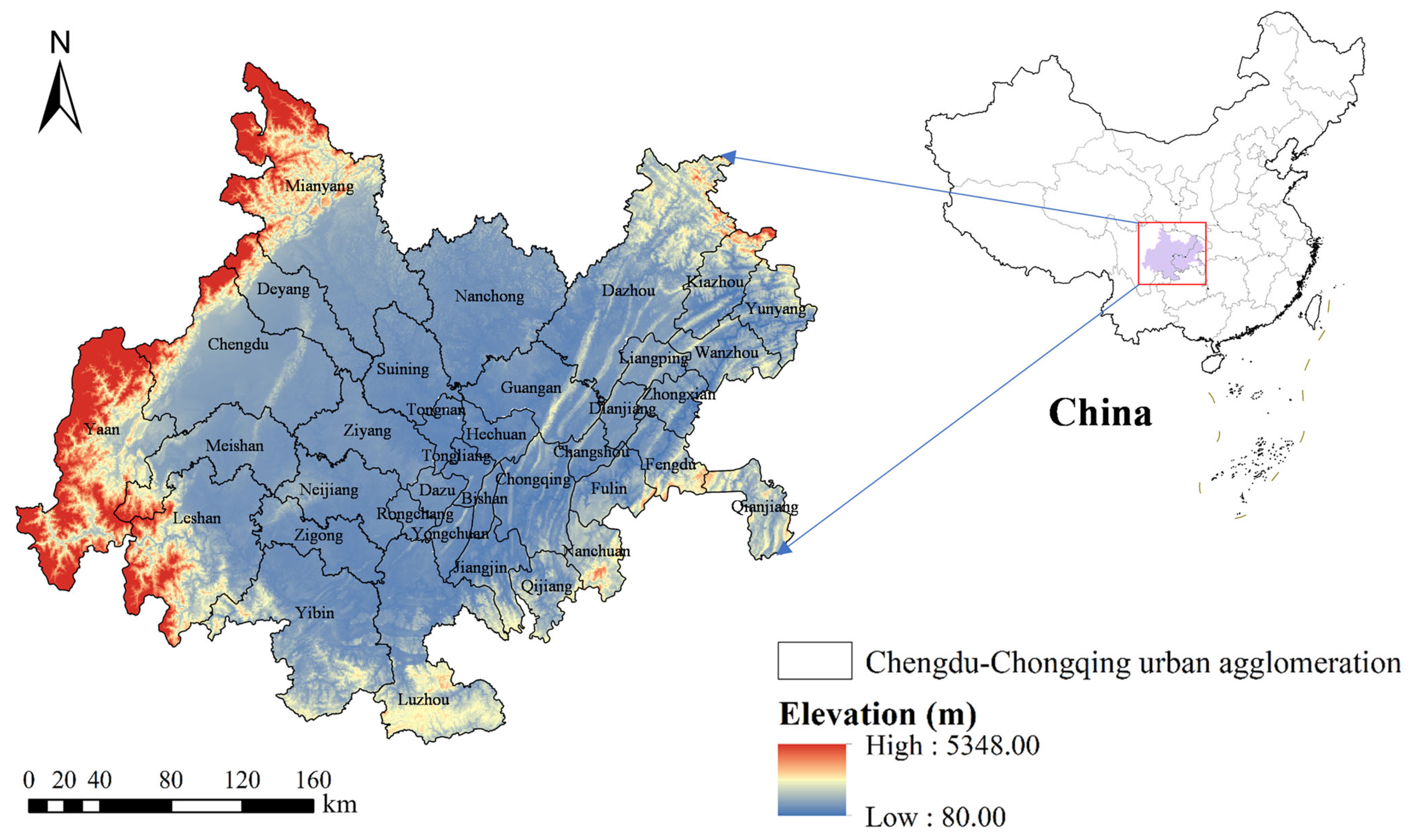
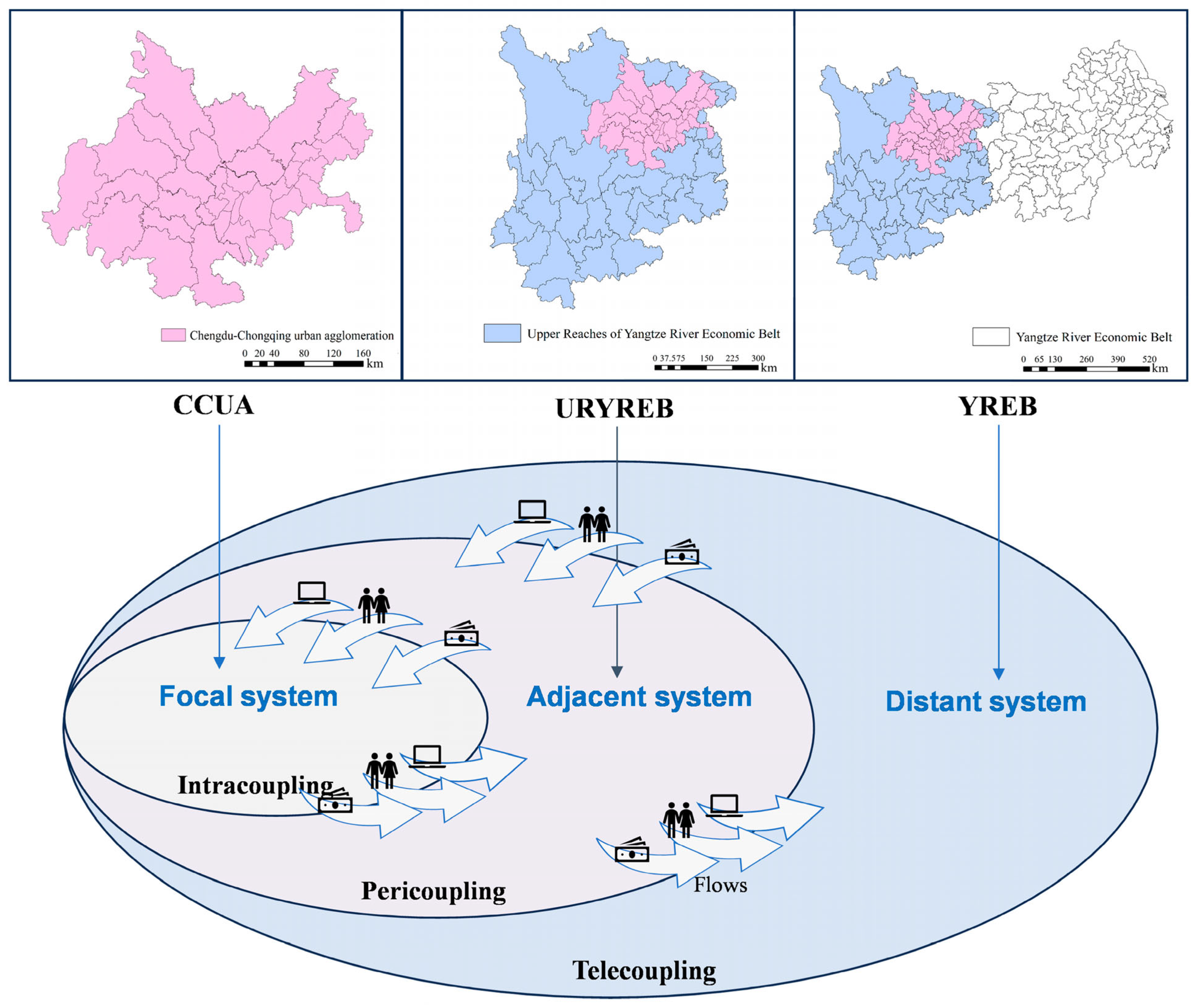
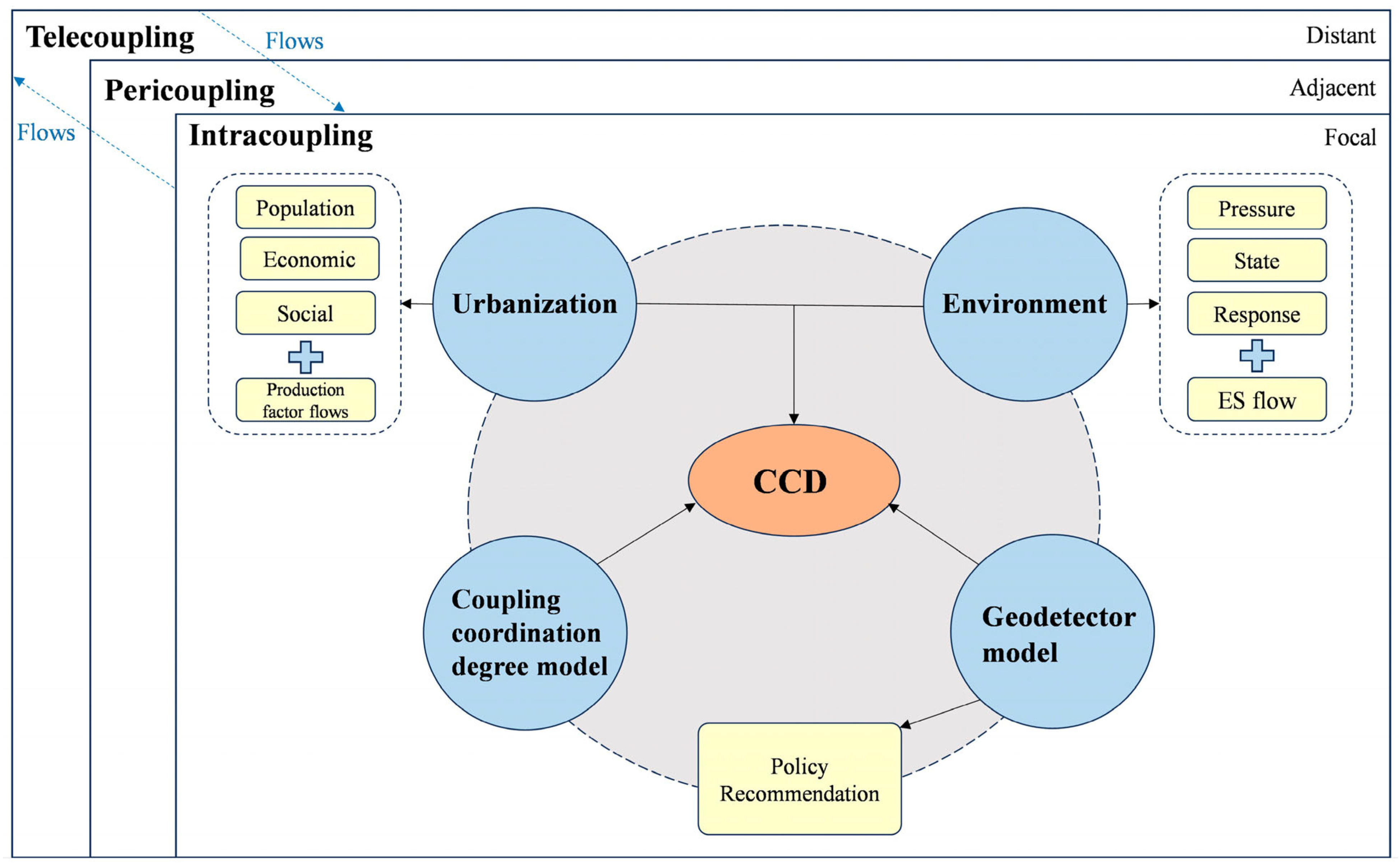

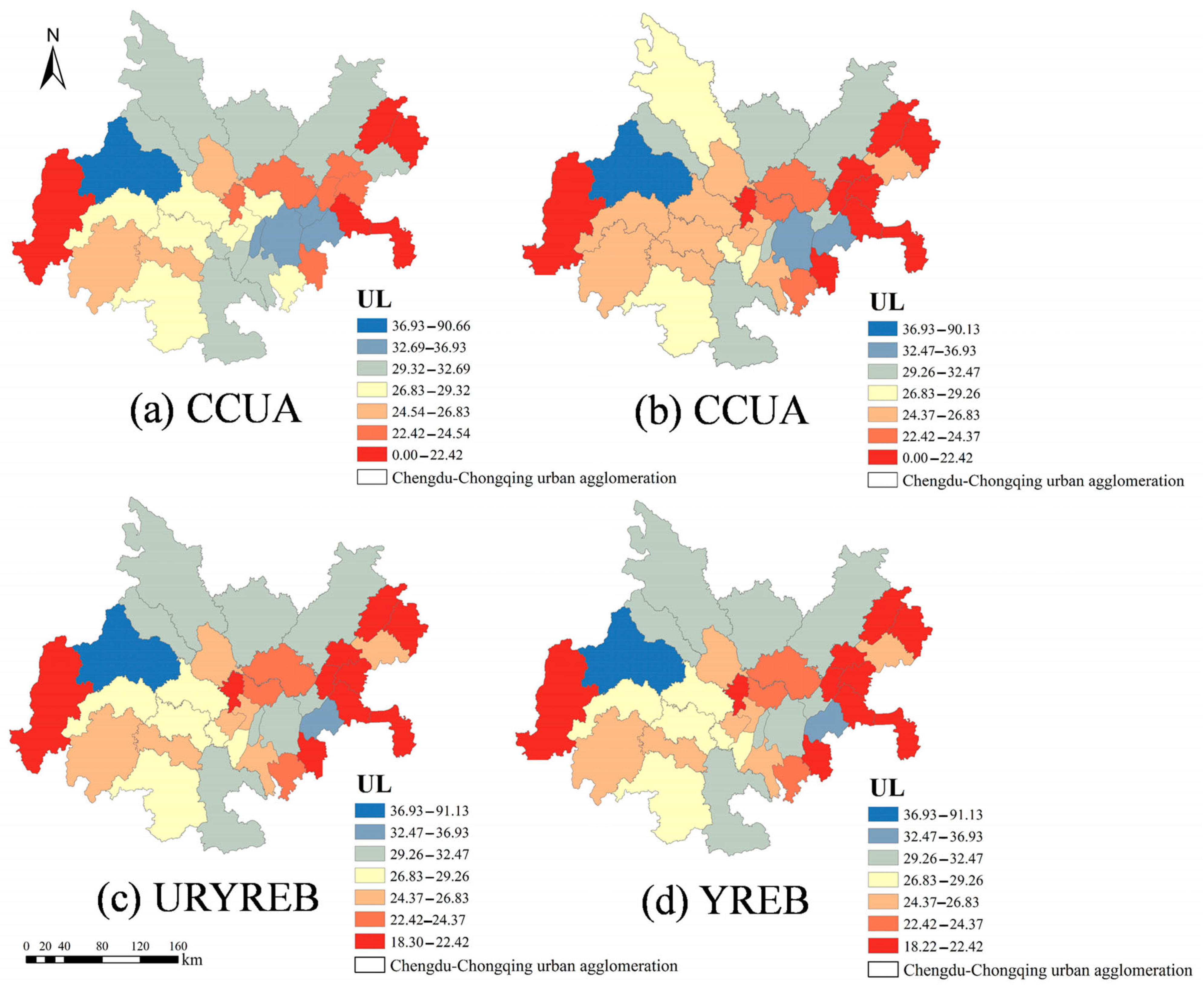


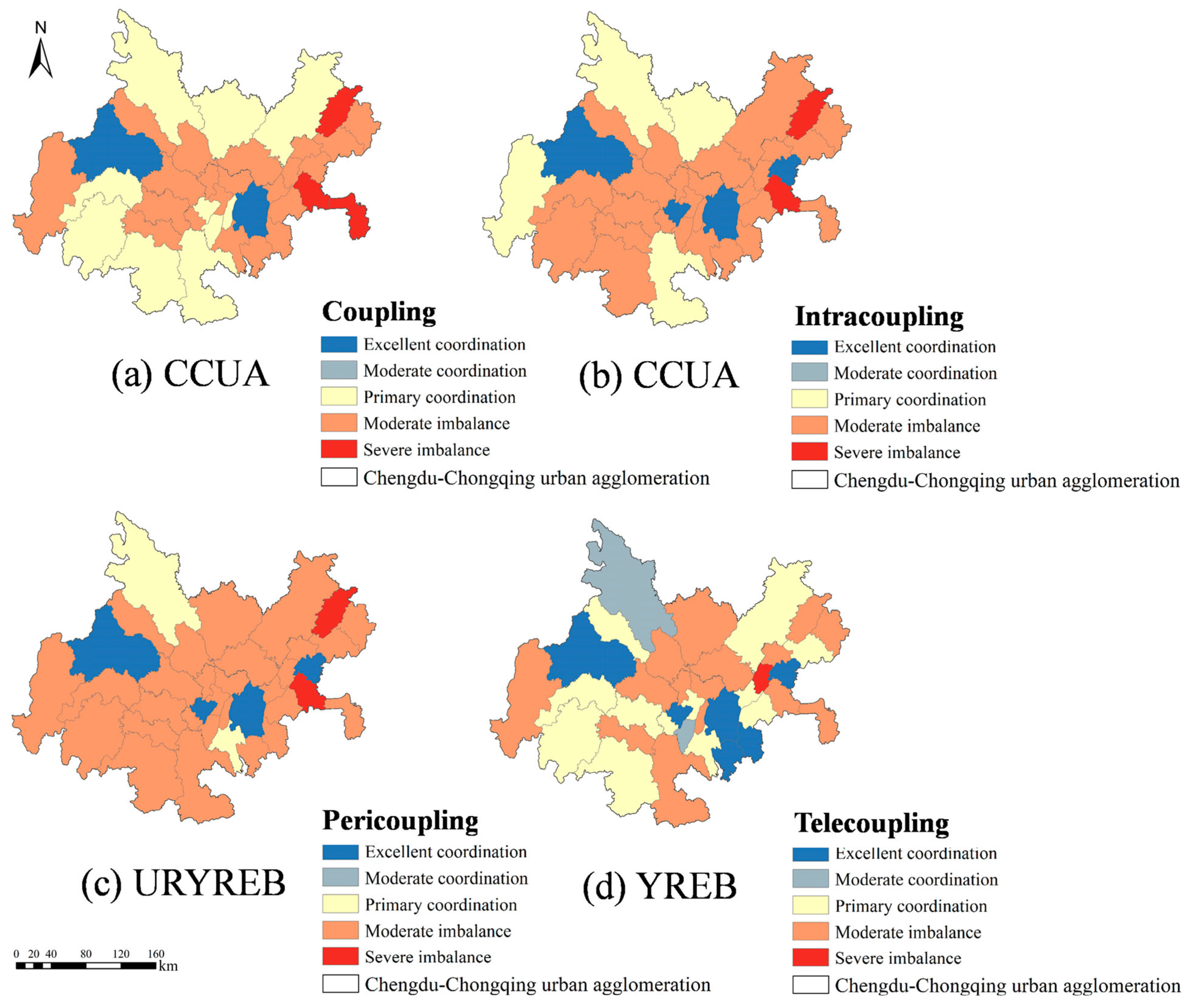
| System | Subsystem | Indicator | Unit |
|---|---|---|---|
| Urbanization | Population urbanization | Proportion of urban population | % |
| Proportion of employees in the secondary and tertiary industry | % | ||
| Population flow | / | ||
| Economic urbanization | Per capita GDP | CNY | |
| Proportion of secondary and tertiary industries in GDP | % | ||
| Economic flow | / | ||
| Social urbanization | Number of hospital and health center beds per capita | Bed | |
| Medical technicians per capita | Person | ||
| Information flow | / | ||
| Environment | Pressure | Industrial wastewater discharge | 10 thousand tons |
| Industrial SO2 emissions | 10 thousand tons | ||
| Industrial dust emissions | 10 thousand tons | ||
| State | The cover rate of forest | % | |
| Green coverage rate in built-up areas | % | ||
| Park green area per capita | m2 | ||
| Response | Household garbage treatment rate | % | |
| Industrial solid wastes comprehensively utilized rate | % | ||
| Domestic sewage treatment rate | % |
| Type | Description |
|---|---|
| Nonlinear weakening | q(X1∩X2) < Min (q(X1), q(X2)) |
| Nonlinear enhancement | q(X1∩X2) > q(X1) + q(X2) |
| Single-factor nonlinear weakening | Min (q(X1), q(X2)) < q(X1∩X2) < Max (q(X1), q(X2)) |
| Double-factor enhancement | Max (q(X1), q(X2)) < q(X1∩X2) |
| Independent | q(X1∩X2) = q(X1) + q(X2) |
Disclaimer/Publisher’s Note: The statements, opinions and data contained in all publications are solely those of the individual author(s) and contributor(s) and not of MDPI and/or the editor(s). MDPI and/or the editor(s) disclaim responsibility for any injury to people or property resulting from any ideas, methods, instructions or products referred to in the content. |
© 2025 by the authors. Licensee MDPI, Basel, Switzerland. This article is an open access article distributed under the terms and conditions of the Creative Commons Attribution (CC BY) license (https://creativecommons.org/licenses/by/4.0/).
Share and Cite
Huang, Y.; Ye, L.; Jiang, Q.; Wang, Y.; Wan, G.; He, P.; Zhou, B. Optimizing Cross-Regional Mobility Contributes to the Metacoupling Between Urbanization and the Environment for Regional Sustainability. Land 2025, 14, 1682. https://doi.org/10.3390/land14081682
Huang Y, Ye L, Jiang Q, Wang Y, Wan G, He P, Zhou B. Optimizing Cross-Regional Mobility Contributes to the Metacoupling Between Urbanization and the Environment for Regional Sustainability. Land. 2025; 14(8):1682. https://doi.org/10.3390/land14081682
Chicago/Turabian StyleHuang, Ying, Lan Ye, Qingyang Jiang, Yufeng Wang, Guo Wan, Peiyun He, and Bo Zhou. 2025. "Optimizing Cross-Regional Mobility Contributes to the Metacoupling Between Urbanization and the Environment for Regional Sustainability" Land 14, no. 8: 1682. https://doi.org/10.3390/land14081682
APA StyleHuang, Y., Ye, L., Jiang, Q., Wang, Y., Wan, G., He, P., & Zhou, B. (2025). Optimizing Cross-Regional Mobility Contributes to the Metacoupling Between Urbanization and the Environment for Regional Sustainability. Land, 14(8), 1682. https://doi.org/10.3390/land14081682











